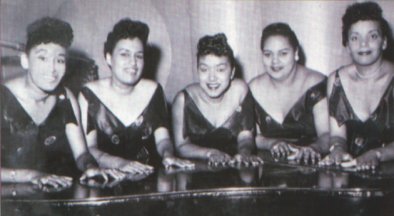10.6.5 The D’Aida Quartet.

In 1952, sisters Haydee and Omara Portuondo decided to form a duo again. They met Elena Burke and presented the project to her. At that moment, the idea of creating a mixed vocal group arose. In the halls of the old CMQ, they met Aida Diestro, who was involved in the Feeling movement and would act as pianist and director. The latter suggested modifying the project and forming a quartet with only female voices. To this end, they called Moraima Secada, whom they all already knew, as she came from Las Anacaonas. Thus, the Las D’Aida quartet was formed.
Aida boasts a surprising sense of harmony and begins to work on the voices of each of the members, trying to take advantage of each one’s vocal range and creating a true ensemble of the four voices.
Just a month after the quartet’s founding, they made their debut on August 16, 1952, on the television program Carrusel de las sorpresas. Accompanied by Aida on piano and double bass, they performed the highly successful songs “Mamey Colorado” and “Cosas del Alma.”
A few days after their first performance, producer Amaury Pérez Sr. called them to work on another television program for a week, called El Show del Mediodía (The Midday Show). Contracts for cabarets followed. They began at a cabaret on Infanta Street called La Campana and doubled at Club 21 (21st Street corner N, Vedado, Havana). These were followed by the Montmatre cabaret, where the group’s prestige grew.
During those years they traveled to New York, performing on Steve Allen’s television show, from there they would move on to Venezuela, Mexico and Argentina.
In 1957, Las D’Aida recorded their first album with Chico O’Farrill’s orchestra for RCA Victor. Among the quartet’s best recorded songs are “Las Mulatas del Chachachá,” “Oye mi ritmo,” “Tabaco verde,” and “Nocturno antillano.”
The quartet had a vast repertoire, including works by prestigious composers such as Eliseo Grenet, José Antonio Méndez, César Portillo de la Luz, Ernesto Lecuona, Adolfo Guzmán, René Touzet, Orlando de la Rosa, Armando Oréfiche and Rafael Hernández.
Since its inception, the Las D’Aida quartet has undergone changes in its lineup; figures such as Elena Burke, Omara Portuondo, Moraima Secada (founders); Leonora Rega, Xiomara Valdés, Lilita Peñalver, Maricela Ramírez, Alicia Fraga, Cary Dolet, Magaly Linares, and Aymée Cabrera, among others, have slipped through the ranks; but what has undoubtedly distinguished this quartet has been its continued adherence to the direction forged by its creator.
Elena Burke left the quartet in 1958 to pursue a solo career, followed by Moraima. Leonora Rega joined the group and participated in the tour of Argentina. The D’Aida continued their great success and performed in 1959 at the Comodoro (3rd and 84th Streets, Miramar, Playa, Havana) and the Parisién (Oth and 21st Streets, Vedado, Havana).
In 1960, Haydée also left the quartet, and Lilita Peñalver joined the group. The group performed in a show titled Canciones en la Noche at the Hotel Nacional (O and 21st Streets, Vedado, Havana). After performing at Club 21 (21st Street and N, Vedado, Havana), they received an invitation to the Aquarelle Tropicale show in Florida. Haydée joined the group for this opportunity.
The quartet established itself in the early 1960s as one of the leading groups in the interpretation of Feeling. Following the departure of Leonora Rega, Flor Rocha joined the group; and Xiomara Valdés also joined, replacing Carmen. With this group, Las D’Aida toured internationally, covering Germany, Russia, Poland, Czechoslovakia, and Hungary in 1962 and 1963, accompanied by other Cuban artists.
Between 1964 and 1968, Las D’Aida performed three times a day. They performed twice a night at Tropicana (4504 72nd Street, Marianao, Havana) as part of the shows Buenos días Inti, Son, and Ritmo. They could also be heard earlier in the day at the Patio del Habana Libre (L and 23rd Streets, Vedado, Havana).
In 1965, the quartet achieved success with their performance of “Solo pideras Chachachá” at the Varadero International Song Festival. The following year, the group performed at the Pabellón Cuba de la Rampa (23rd and N Streets, Vedado, Havana) as part of the Latin American Theater Festival.
In 1967, Omara Portuondo launched her solo career. Alicia Fraga took over the role. The quartet regularly appeared on radio and television programs and also performed in other provinces of the country.
In 1970, the “companion group” was created, adding a new sound and harmonic and rhythmic support to its members’ voices with the addition of electronic instruments and batá drums. This was one of the first Cuban popular music groups to incorporate batá drums into their accompaniment; these were previously used only in religious ceremonies by Yoruba groups.
Aida Diestro died in October 1973. The quartet was reduced to three voices: Teresa García Caturla, Cary Dolet, and Magaly Linares. The direction of the quartet was assumed by siblings Teresa and Ramón García Caturla. Under the new direction, the quartet continued to give the best of our music, reaping successes confirmed by their tours in Panama (1978), Granada (1979), Mexico (1983), Spain (1984), Angola (1986), and Finland (1987).
The Las D’Aida quartet, apart from Feeling, marked the line of traditional Cuban music (Son, Chachachá).
In 2007, at the Amadeo Roldán Theater (Calzada y D, Vedado, Havana), the quartet paid tribute to Aida Diestro. All the voices that worked with Aida appear on stage, while those who have passed away are remembered by those who can participate in the performance. The Las D’Aida Quartet performs, among other songs, “Ya no me quieres” (You Don’t Love Me Anymore) and “El Mundo” (The World).








